 Last Updated February 9, 2025
Last Updated February 9, 2025
The most common Vitamix shopper’s question is some variant of, “I want to make smoothies, soups, and frozen desserts. Which Vitamix blender is best for me?” The answer is that all Vitamix machines work great for those tasks; which one is best depends on the volumes you want to blend and whether you want to pay for extra features.
If you don’t want to go through the nitty-gritty, here are my quick Vitamix recommendations:
Which is the best Vitamix model?
Best Value
- E310 (short/narrow container for small to medium amounts)
- Recon 5200 (tall/narrow container for small to large amounts)
- Recon E320 (short/wide container for medium to large amounts)
Money Is No Object
- Ascent X5 (latest and greatest)
The February 2025 shopping landscape
Most Vitamix models are on sale through Feb 22nd for the President’s Day Sale. Here is the sale.
Vitamix recently released a new set of Ascent models. Full details are in my Vitamix Ascent X Series Review.
The Food Processor Attachment gives more reason to consider Ascent and Venturist models, since it is not compatible with classic models. If you don’t care about the premium finish of the A3500, consider saving big on the Reconditioned Venturist.
If you are looking for the lowest possible price, I recommend choosing between the Recon 5200, the E310, and the Recon E320. The most significant difference between these models is the container they come with, so use the following Venn diagram to pick the optimal container for you. There are trade-offs between the three container options. To put it briefly, “short, narrow, or large capacity: pick 2”: 
Note to visitors from outside the United States: The model availability described on this page is for the USA (and APO/FPO addresses). If you are shopping from Canada, check out my page about Canadian Vitamix models.
For most people, I recommend choosing from the following four categories: Certified Reconditioned models, Explorian, Premium Classic, and Ascent.
Reconditioned
 If you are looking for the lowest possible price on Vitamix, reconditioned is for you. Some people are hesitant to buy reconditioned, and that is a valid concern with some companies, but Vitamix’s reconditioned units are guaranteed to be top quality. The only reasons I would avoid reconditioned Vitamix are if it is for a gift for someone who won’t understand, or if you want some of the features not available on reconditioned machines.
If you are looking for the lowest possible price on Vitamix, reconditioned is for you. Some people are hesitant to buy reconditioned, and that is a valid concern with some companies, but Vitamix’s reconditioned units are guaranteed to be top quality. The only reasons I would avoid reconditioned Vitamix are if it is for a gift for someone who won’t understand, or if you want some of the features not available on reconditioned machines.
Explorian
 If you prefer a slightly smaller container, I highly recommend the new E310, which comes with a short and narrow 48-oz container (full review). The Explorian E320 is functionally identical to the E310, but it comes with a wide container. That makes it nearly identical to the 5300. (The E320 replaces the 5300 in the model lineup, and it is mostly the same, with a few changes: it does not have the on-off switch on the side, and it does not light up when on. I don’t think these differences matter much, but there they are for anyone wondering about E320 vs. 5300.)
If you prefer a slightly smaller container, I highly recommend the new E310, which comes with a short and narrow 48-oz container (full review). The Explorian E320 is functionally identical to the E310, but it comes with a wide container. That makes it nearly identical to the 5300. (The E320 replaces the 5300 in the model lineup, and it is mostly the same, with a few changes: it does not have the on-off switch on the side, and it does not light up when on. I don’t think these differences matter much, but there they are for anyone wondering about E320 vs. 5300.)
There is now also an Explorian E520, which comes with the wide 64-oz container and adds 3 preset blending modes. With the hidden discount that gets activated after clicking a Vitamix link on this site and then adding the Recon E520 to your shopping cart, it is an excellent deal.
Premium Classic and Propel
If you want the most premium machine, but don’t want the new technology of Ascent, then the Professional Series 750 is for you. I think the Ascent machines are quite nice, but you might not like the look of their digital display, or you might want to be able to use older containers (without NFC chips).
In 2023 Vitamix released a new Series, which they are calling the Propel. Similar to the Pro 750, these machines have preset modes and a secondary on-off switch. The Propel machines also have the subtly updated styling that was released with the Explorian series: Propel 510 and Propel 750.
Ascent (Smart System Blenders)
If you want to buy into the future of Vitamix, the Ascent Series is the way to go. It’s priced in the same range as new Legacy models, but it comes with various upgrades (among them: longer warranty, timer display, can use small cups without bulky adapter, and a wireless connection to smartphone app).

 Within the Ascent Series, the A2300 is the lowest-priced model and it has everything you need. (If you’re buying reconditioned, the A2500 is the lowest-priced model, and it has all the features of the A2300, including full variable speed control, and it adds 3 preset program modes.) If you feel like upgrading, I recommend going all the way up to the A3500, because it has premium finish options. (I’m not saying that the intermediate Ascent models are a bad choice, they just wouldn’t be my choice.) See my Ascent review page for more details.
Within the Ascent Series, the A2300 is the lowest-priced model and it has everything you need. (If you’re buying reconditioned, the A2500 is the lowest-priced model, and it has all the features of the A2300, including full variable speed control, and it adds 3 preset program modes.) If you feel like upgrading, I recommend going all the way up to the A3500, because it has premium finish options. (I’m not saying that the intermediate Ascent models are a bad choice, they just wouldn’t be my choice.) See my Ascent review page for more details.
If you’ve been putting off getting a Vitamix because you’re saving up, you can get one right away with a payment plan. If you make on-time payments, there are zero financing fees.
You can leave a comment below or contact me if you are still having trouble deciding which one to get.
Comparison of pre-Ascent models follows
If you want to quickly see the relation between all of the different Vitamix models, you can jump ahead to my comparison chart.
I made an interactive tool to help explore the different features. Try playing with it to get a sense of which you are interested in. You can click any model to go to its Vitamix.com page, or you can read more about the different models below.
+ Show model selection tool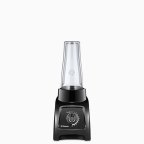 Recon S30
Recon S30  Recon 2-Speed
Recon 2-Speed  Recon 5200
Recon 5200  Recon 5300
Recon 5300  Recon Pro 500
Recon Pro 500 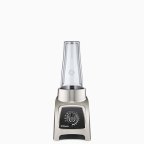 Recon S55
Recon S55  S30
S30  2-Speed
2-Speed 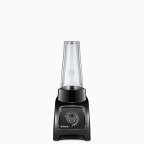 S50
S50  Recon 7500
Recon 7500  5200
5200  S55
S55 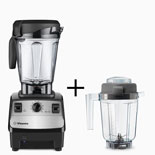 Recon 5300 + 32oz
Recon 5300 + 32oz  Recon Pro 750
Recon Pro 750  7500
7500  Pro 500
Pro 500  Recon 7500 + 32oz
Recon 7500 + 32oz  Pro 750
Pro 750 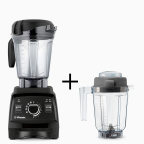 Recon Pro750+32oz
Recon Pro750+32oz  7500 + 32oz
7500 + 32oz  Pro 750 + 32oz
Pro 750 + 32oz  780
780 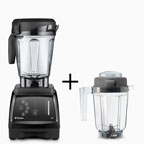 780 + 32oz
780 + 32oz(If you want the 32-oz container, you have to add it to your cart separately: 32-oz container link)
If you’re overwhelmed by the choices and just want to know my preference, I’ve used all of the different types of Vitamix blenders, and before I started using Ascent, the one I used on a daily basis was the 7500, with an extra 32-oz container for blending smaller amounts. (For the best deal, check out certified reconditioned.) All of the models are excellent, and I don’t think there is a wrong choice. (Plus, if you change your mind in the first 30 days, you can get a full refund, including free shipping both ways.)
Summary of Differences
These are the five key decisions to make when deciding which Vitamix to buy:
The following comparison chart shows the relations between the different machines in the S-Series, C-Series, and G-Series. The machines within most boxes of the chart are identical, but they come with different accessories and cookbooks (the exceptions are the S50 and S55, where the S55 has 2 more presets than the S50, and the Pro 750 and Vitamix 780, where the 780 has a flat touchpanel control). Generally the differences in accessories/cookbooks are pretty marginal, so I’d recommend going for the lowest price model within the box.

(“+” indicates there are also more expensive options in addition to the price listed in the chart. The following machines are not shown because they do not fit in with the rest: the Vitamix Turboblend Two Speed and Three Speed lack variable speed control, and the Vitamix 5300 and 6500 are a hybrid of the 6300 and 7500—i.e. they have a 7500 container on a 6300 base, without or with presets.)
Personal Blender? (S-Series vs. C-Series and G-Series)
(Vitamix S30 and S55 vs. 5200, 7500, et al.)
 In 2014 Vitamix released the Vitamix S30. It is smaller than the other Vitamix models, and also comes with a combination blending container/to-go smoothie cup. The Vitamix S50 and Vitamix S55 came out in 2015, and they are the same as the S30 but add preset modes. Since these models are significantly different from all the other models, I put up a detailed Vitamix S30 and S-Series review. If you are considering a smaller blender, or like the idea of blending in a to-go smoothie cup, you should check them out. Not surprisingly, the S-Series’ smaller size means that their maximum capacity is lower the other models (40 oz vs 64 oz).
In 2014 Vitamix released the Vitamix S30. It is smaller than the other Vitamix models, and also comes with a combination blending container/to-go smoothie cup. The Vitamix S50 and Vitamix S55 came out in 2015, and they are the same as the S30 but add preset modes. Since these models are significantly different from all the other models, I put up a detailed Vitamix S30 and S-Series review. If you are considering a smaller blender, or like the idea of blending in a to-go smoothie cup, you should check them out. Not surprisingly, the S-Series’ smaller size means that their maximum capacity is lower the other models (40 oz vs 64 oz).
Variable Speed?
(Vitamix Two Speed vs. 5200 and Vitamix 6000 vs. 6300)
 The variable speed control found on all Vitamix machines except for the Two Speed and 6000 is useful for when you don’t want to fully liquefy your blend. Examples are pesto, salsa, or chopping vegetables. If you don’t have variable speed, you can get away with quickly pulsing, but you won’t have quite as much control. The variable speed also makes the “bubble removal trick” more effective, although pulsing on low speed also works.
The variable speed control found on all Vitamix machines except for the Two Speed and 6000 is useful for when you don’t want to fully liquefy your blend. Examples are pesto, salsa, or chopping vegetables. If you don’t have variable speed, you can get away with quickly pulsing, but you won’t have quite as much control. The variable speed also makes the “bubble removal trick” more effective, although pulsing on low speed also works.
Preset Programs?
(Vitamix Two Speed vs. 6000, Vitamix 5200 vs. 6300, Vitamix Professional Series 200 vs. Professional Series 500, Vitamix S30 vs. S55, and Vitamix Professional Series 300 vs. Professional Series 750)
 The preset programs on the 6000, 6300/Pro 500, S55, and Pro 750 allow you to select a program, turn it on, and then the machine will automatically ramp up the speed and then shut off after a certain amount of time. There are a number of reasons that people appreciate this function:
The preset programs on the 6000, 6300/Pro 500, S55, and Pro 750 allow you to select a program, turn it on, and then the machine will automatically ramp up the speed and then shut off after a certain amount of time. There are a number of reasons that people appreciate this function:
• You can start the machine and “walk away” to do something else.
• If you strictly follow recipes the presets can yield more consistent results.
• Presets can give new users more confidence with the machine.
However, the presets do not work perfectly every time. Sometimes ingredients require tamping to start circulating past the blades, so you can’t always “walk away.” Also, the preset time might not be the optimum blending time if you modify a recipe. You may find that your smoothie is not fully blended after the smoothie program runs, so you have to run it again. A commercial coffee or smoothie shop makes the same recipes over and over, so in that setting presets are extremely useful. If you constantly make new combinations and of differing amounts, as many home users do, the settings may be less useful. It’s not too hard to tell when something is sufficiently blended, and after a few trials anyone should be able to figure it out. For these reasons, I personally would not pay extra for the preset settings. However, I know many people who have the presets love them. One thing to remember is that the machines with presets still have the variable speed knob for full manual control. If you don’t mind the added cost of presets, you can always switch back and forth to manual control.
C-Series vs. G-Series (Next Generation)?
(Vitamix 5200 vs. 7500, and Vitamix Professional Series 500 vs. Professional Series 750)
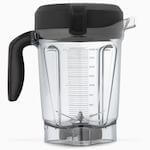 Vitamix released the “Next Generation,” aka “G-Series,” models in 2012. Both the base and the pitcher have an updated design. The base has slightly better sound muffling and also has better airflow which means that it can work harder before it overheats. To go with the better-cooled motor, the updated pitcher has a 4-inch blade instead of the Standard/Classic “C-Series” 3-inch blade. The 4-inch blade is in a shorter and wider container that has the same capacity as the 64-oz C-Series container.
Vitamix released the “Next Generation,” aka “G-Series,” models in 2012. Both the base and the pitcher have an updated design. The base has slightly better sound muffling and also has better airflow which means that it can work harder before it overheats. To go with the better-cooled motor, the updated pitcher has a 4-inch blade instead of the Standard/Classic “C-Series” 3-inch blade. The 4-inch blade is in a shorter and wider container that has the same capacity as the 64-oz C-Series container.
Advantages of the wider design:
• less need for the tamper (ingredients fall into the blades more easily)
• better chopping capability (you can course-chop more ingredients at a time)
• easier to scrape thick mixtures out
Advantage of shorter design:
• easier storage (at 17.5” tall, the container with lid on the base fits under standard kitchen cabinets)
Advantages of the 4-inch blade:
• faster processing time
• under some circumstances, marginally smoother blends
The one disadvantage of the new container is that for small volumes of under ~2 cups it does not work quite as well as the C-Series narrow container. The G-Series wider design causes two things to happen. First, there is more splashing up onto the inside of the lid and upper walls of the container, which means you lose a small amount of your blend unless you carefully scrape off the lid and walls. Second, you need slightly more volume to cover the blades and get good circulation going. The minimum volume to blend depends on what you are blending, and also on how much effort you are willing to spend pushing ingredients back into the blades. For example, for best results, the narrow containers can make nut butter easily by starting with 3 cups of nuts, whereas the wider Next Generation containers do best with 4 cups of nuts. For easier, more liquidy, blends, you can go below 1 cup in either container, but Next Generation containers will splash around more.
This disadvantage is a non-issue if most of your blends are over 2 cups, or if you are willing to spend a bit more to buy an additional narrow container, which will give you the best of both worlds. I like the 32-oz container for this purpose, although the 48-oz container has the same narrow bottom so it works just as well. The 48-oz container is just a bit bulkier on the outside because it sits outside the centering posts instead of inside of them, and its top is wider as well.
(The narrow C-Series Vitamix containers are compatible with G-Series models, but the G-Series containers are not recommended for use on C-Series models. The longer G-Series blades increase the load, and Vitamix does not recommend the C-Series cooling system for those increased loads.)
Reconditioned?
 Buying reconditioned is a great way to save money. For more details on deciding about buying reconditioned, see my refurbished Vitamix page.
Buying reconditioned is a great way to save money. For more details on deciding about buying reconditioned, see my refurbished Vitamix page.
Continue on for more details of each model type…
The array of different Vitamix blenders is a bit confusing, but it turns out that there is a lot of redundancy between the different models. I am only discussing models made for consumer/home use. Their commercial blenders are not ideal for home use because they are generally more expensive and have shorter warranties (3 years vs 7 years for home use; they are warrantied for constant use—think of how many times per day a blender at Jamba Juice runs compared to at your home).
The Vitamix website currently lists over 30 different home models, but they are all variants of three main designs: “personal” (S-Series), “standard/classic” (C-Series), and “next generation” (G-Series). For each of these main designs there are a few different options, to make a total of 8 different machine types. The rest of the models have identical bases, but come with different containers and/or accessories.
S-Series Motors
If the smaller size, dishwasher safe container, and “to-go” blending container appeal to you, please read the full details at my Vitamix S30, S50, and S55 review. For quick reference, the size of the base is 8.3″ deep x 5.9″ wide x 7.7″ tall. With the 20-oz to-go container the total height is 14.55″. The height is 15.66″ with the 40-oz container. These models have lower power, but they are still capable of making all of the usual Vitamix creations, just in smaller quantities.
C-Series Motors (Standard/Classic)
There are three types of bases of the standard variety. The differences are in the controls. The dimensions of the base of these machines are 8.75″ deep x 7.25″ wide x 8.25″ tall. There are three different container size options: 32 oz, 48 oz, and 64 oz, which result in height of base plus container/lid of 16.9″, 17.4″, and 20.5″ respectively.
Standard, no-variable speed (Vitamix TurboBlend Two Speed and Three Speed)
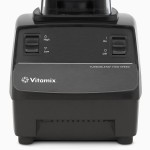 TurboBlend Two Speed (
TurboBlend Two Speed ($399$349); reconditioned for $299. This machine comes with a 5-year warranty and lacks the variable speed knob. Variable speed is useful for cases where you want to have finer control over the texture (i.e. if you don’t want a totally smooth purée). However, you can accomplish some non-liquefying chopping tasks by quickly pulsing the machine. While this is the most affordable new machine, I’d highly recommend looking at the reconditioned 5200, which has the same warranty and adds variable speed for $70 less.
In May 2016 Vitamix came out with a new no-variable speed machine, the TurboBlend Three Speed($499). It is exactly what it sounds like: it has three speed settings: low, medium, and high. It also has a pulse switch, which does the same thing as switching the start-stop button on and off. The pricing on this model is a bit strange, since for $50 less you can get a machine with fully variable speed. Plus, the TurboBlend 3-Speed comes with a 5-year warranty, instead of the 7 years on machines like the 5200.
Standard variable speed (Vitamix 5200 et al.)
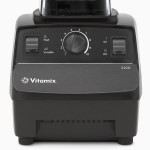 Until recently this was Vitamix’s bread and butter, and they have a lot of models to show for it: 5200 ($449), TurboBlend VS (retired), CIA Pro (retired), Pro 200 ($499), Creations II ($449), and Creations GC (retired); reconditioned for $329. These machines are essentially identical. Some are available with a shorter 48-oz container instead of the 64-oz container. The smaller container is nice because it’s more compact (and fits under standard kitchen cabinets), but of course its capacity is lower. The aesthetics of the switches and dial are slightly different between the different models. The Creations models come with a 5-year warranty, while the rest are 7 years. The 5200 comes with their “whole foods cookbook,” the TurboBlend VS comes with a vegetarian/vegan/raw cookbook and a nutmilk straining bag, the Pro models come with a cookbook with restaurant-oriented recipes (the CIA one—that’s Culinary Institute of America—comes with an additional recipe book). Note that if you buy reconditioned, you cannot choose which of the Standard models you are getting; Vitamix will choose for you based on availability, but remember that functionally they are identical.
Until recently this was Vitamix’s bread and butter, and they have a lot of models to show for it: 5200 ($449), TurboBlend VS (retired), CIA Pro (retired), Pro 200 ($499), Creations II ($449), and Creations GC (retired); reconditioned for $329. These machines are essentially identical. Some are available with a shorter 48-oz container instead of the 64-oz container. The smaller container is nice because it’s more compact (and fits under standard kitchen cabinets), but of course its capacity is lower. The aesthetics of the switches and dial are slightly different between the different models. The Creations models come with a 5-year warranty, while the rest are 7 years. The 5200 comes with their “whole foods cookbook,” the TurboBlend VS comes with a vegetarian/vegan/raw cookbook and a nutmilk straining bag, the Pro models come with a cookbook with restaurant-oriented recipes (the CIA one—that’s Culinary Institute of America—comes with an additional recipe book). Note that if you buy reconditioned, you cannot choose which of the Standard models you are getting; Vitamix will choose for you based on availability, but remember that functionally they are identical.
Sometimes these models are listed with their color-specific SKU. All of the following models are identical to the 5200, they just come with different colors and names: Vitamix 1709, 1363, 1364, 1365, 1709, 1723, 1732. They also sometimes go by VM0103. Vitamix 1978 is also the same, but comes with a 48-oz container.
Standard variable speed + presets (Vitamix 6300 and Professional Series 500)
 Pro 500 ($559) and 6300 (retired); reconditioned for $379. These are the same model; the only difference is that the 6300 comes with the “Savor” cookbook, which has a broader range of recipes than the Pro 500’s “Create” cookbook, which focuses more on restaurant-style recipes that tend to be richer.) They have 3 preset programs that run the blender for a certain amount of time and speed for smoothies, frozen desserts, and hot soups. Their switches are slightly different from the non-preset models. The non-preset models have an on-off switch, a variable speed knob, and a high-variable speed switch. The preset ones have moved the highest speed setting onto the knob and replaced the high-variable speed switch with a pulse switch. This is really a minor aesthetic difference, since you can achieve pulsing on the non-preset models by quickly flicking the on-off switch on and off.
Pro 500 ($559) and 6300 (retired); reconditioned for $379. These are the same model; the only difference is that the 6300 comes with the “Savor” cookbook, which has a broader range of recipes than the Pro 500’s “Create” cookbook, which focuses more on restaurant-style recipes that tend to be richer.) They have 3 preset programs that run the blender for a certain amount of time and speed for smoothies, frozen desserts, and hot soups. Their switches are slightly different from the non-preset models. The non-preset models have an on-off switch, a variable speed knob, and a high-variable speed switch. The preset ones have moved the highest speed setting onto the knob and replaced the high-variable speed switch with a pulse switch. This is really a minor aesthetic difference, since you can achieve pulsing on the non-preset models by quickly flicking the on-off switch on and off.
Some people love the presets because you can set it and walk away (assuming the mixture is circulating and you don’t need the tamper), and because they get more consistent results. However, the more consistent results will only hold if you always add the same quantities and types of items to the blender. For example, if you’re making a small smoothie, you can blend it for less time than if you were making a large one. One other thing is that you can set the non-preset machines and walk away—you just have to come back to stop them. I often use the blending time to rinse off the knife and cutting board that I used. You’re not likely to forget that the Vitamix is running because it’s loud enough to hear throughout the house. The variable speed knob goes to the same high speed as the previous models on high, but it’s lowest setting is a bit faster than on the 5200 et al., so you lose a tiny bit of fine control. Whether the presets are worth it is a personal question—I wouldn’t pay extra for them, but some people love them.
Standard no variable speed + presets (Vitamix 6000)
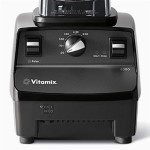 6000 (retired). Released October 2013, this is more of a mash-up of existing machines than a truly new one. It’s a sort of blend between the Two Speed, and the 6300. It does not have variable speed control, but it has six preset timed blending settings. These settings will automatically ramp up the speed, and then turn it off after a specified time of 20 sec, 30 sec, 1 min, 1.5 min, 4.5 min, or 6.5 min. Like the 6300, the pulse control is spring-loaded so that it only stays on as long as you hold it down, and it blends at a medium-low speed.
6000 (retired). Released October 2013, this is more of a mash-up of existing machines than a truly new one. It’s a sort of blend between the Two Speed, and the 6300. It does not have variable speed control, but it has six preset timed blending settings. These settings will automatically ramp up the speed, and then turn it off after a specified time of 20 sec, 30 sec, 1 min, 1.5 min, 4.5 min, or 6.5 min. Like the 6300, the pulse control is spring-loaded so that it only stays on as long as you hold it down, and it blends at a medium-low speed.
G-Series Motors (Next Generation)
In 2012 Vitamix released a new generation G-Series base with improved airflow that makes it run cooler and quieter than the classic C-Series one. With the improved cooling, the G-Series base can use a new pitcher design that is wider and has longer blades. This design makes the tamper less necessary, and makes it easier to get thick mixtures out. The longer blades also process food faster and work better for chopping. The G-Series machines are compatible with the C-Series containers, so if you want to use the dry blade you can use the same classic dry container. Dimensions are 9.4″ deep x 7.7″ wide x 17.5″ tall (with new-style 64-oz container in place). For more details of sizes, check out the PDF footprints I made for my Vitamix S30 review.
Next generation motor (Vitamix 7500, Professional Series 300, and Creations Elite)
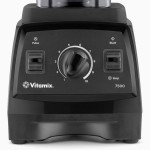 7500 ($529), Creations Elite ($557.50), and Pro 300 ($559); reconditioned for $439. These are all the same machine, so don’t worry about the note on the Reconditioned Next Gen page that says that the label may reflect any of these models. The only difference is the name printed on it. One point of confusion is that the Creations Elite is sold new with a smaller container, but if you happen to get sent a Creations Elite as a Reconditioned Next Gen, it will come with the same low profile 64-oz container that the 7500 comes with.
7500 ($529), Creations Elite ($557.50), and Pro 300 ($559); reconditioned for $439. These are all the same machine, so don’t worry about the note on the Reconditioned Next Gen page that says that the label may reflect any of these models. The only difference is the name printed on it. One point of confusion is that the Creations Elite is sold new with a smaller container, but if you happen to get sent a Creations Elite as a Reconditioned Next Gen, it will come with the same low profile 64-oz container that the 7500 comes with.
Next generation motor + presets (Vitamix Professional Series 750 and Vitamix 780)
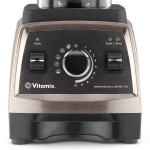
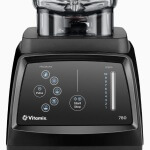 Pro 750 ($599–$649), 780 ($719); available reconditioned: 750 for
Pro 750 ($599–$649), 780 ($719); available reconditioned: 750 for $519–$569$499, and 780 for $519$399. These models have 5 presets: smoothies, frozen desserts, purées, hot soups, and self-washing. If you want to see more details of exactly what the presets do, check out my page about demystifying Vitamix presets. The 780 is identical, except that it has a touchpanel control interface. See my Vitamix 780 review for more details.
Vitamix Heritage 750 vs. Original 750?
In late 2015, Vitamix released a new version of the Pro 750: the Heritage line. The Vitamix Heritage 750 is functionally equivalent to the original Pro 750, but it has two differences on the exterior of the base. The upper shell (see diagram below) is now metal on the Heritage models. The Vitamix website doesn’t put Heritage in the model title, but it’s there in the description.
 The original 750 came in a brushed stainless finish option, but the upper shell was plastic with a thin metallic coat that could be scratched or scuffed. (When I tested the original 750 for a couple of months, I did not see any problems, but I have heard that some people have noticed scratches/scuffs.) The solid metal of the new Heritage models is more durable. Also, the metal shell muffles the the motor a bit more than the plastic, making the Heritage models a bit quieter.
The original 750 came in a brushed stainless finish option, but the upper shell was plastic with a thin metallic coat that could be scratched or scuffed. (When I tested the original 750 for a couple of months, I did not see any problems, but I have heard that some people have noticed scratches/scuffs.) The solid metal of the new Heritage models is more durable. Also, the metal shell muffles the the motor a bit more than the plastic, making the Heritage models a bit quieter.
 The other minor difference is that the Heritage models’ front panel has fewer backlights: Heritage models light up the indicators above the pulse and start-stop switches, whereas the original Pro 750 has backlights around the central knob as well.
The other minor difference is that the Heritage models’ front panel has fewer backlights: Heritage models light up the indicators above the pulse and start-stop switches, whereas the original Pro 750 has backlights around the central knob as well.
The Heritage metal is available in brushed stainless and copper finishes. (Currently on Vitamix.com, the Heritage options are listed on the main Pro 750 page, and the old brushed stainless finish is discontinued.)
I believe it is called Heritage because it is a throwback to the original Vitamix models that had all-metal bases. The plastic that Vitamix has been using for their bases for the past 25 years is extremely durable, so this change won’t affect functional longevity. That said, the elegant finish of the Heritage models will now likely stay unblemished for longer. It’s also nice that Vitamix did not increase the price for this upgrade.
The Vitamix 5300 and 6500
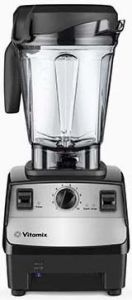 5300 ($529) and 6500 ($599); reconditioned for $360. Vitamix does not currently sell the new models online, only the reconditioned one. These are “new” models for 2015, although they are actually just slightly unexpected mash-ups of previous models. They are a hybrid between a 6300 and a 7500. They use the wide Next Gen (G-Series) container but they have a Classic (C-Series) base. The 5300 has variable speed and a pulse control switch, and has no presets. Meanwhile, the 6500 has the same three presets as the 6300. (Further evidence of equivalence between the 5300/6500 and C-Series models is on the Reconditioned C-Series 6300/Pro 500 page: it says its base may be a 6500.)
5300 ($529) and 6500 ($599); reconditioned for $360. Vitamix does not currently sell the new models online, only the reconditioned one. These are “new” models for 2015, although they are actually just slightly unexpected mash-ups of previous models. They are a hybrid between a 6300 and a 7500. They use the wide Next Gen (G-Series) container but they have a Classic (C-Series) base. The 5300 has variable speed and a pulse control switch, and has no presets. Meanwhile, the 6500 has the same three presets as the 6300. (Further evidence of equivalence between the 5300/6500 and C-Series models is on the Reconditioned C-Series 6300/Pro 500 page: it says its base may be a 6500.)
The reconditioned 5300 is the most affordable option for a machine with the short/wide container.
The strange thing about these models is that previously Vitamix stated that Next Gen containers should not be used on Classic bases because they do not have the updated airflow design that cools the motor more effectively.
I strongly suspect that the 5300 has the same microprocessor speed control as the 7500, Pro 750, and 6300, just without the presets. (You can read about the speed control of the different machines on my Vitamix RPM measurement page.) The microprocessor speed control should help protect the motor when using the wide container at high loads and very low speeds, but at maximum speed it shouldn’t make a difference. The marketing copy for the 5300 says that it comes “with a faster, yet quieter, motor,” but I am skeptical of those claims [Update: interestingly, Vitamix removed that phrase].
The 5300 and 6500 are a bit louder than the G-Series bases, which have sound-dampening technology not present in the C-Series bases. At the same price point, I would prefer the 7500.
Satisfaction Guarantee
Vitamix has a 30-day satisfaction guarantee, so if you have second thoughts you can return a machine within the first 30 days for a full refund and they even pay return shipping.
Warranty
If your machine has any problems during the warranty period of 5 or 7 years, Vitamix will repair or replace it, and they cover shipping costs both ways. For more details about warranties, check out my Vitamix Warranty page.
Reconditioned Vitamix
 I know I already mentioned reconditioned machines, but I want to restate what a great deal I think they are. These factory-refurbished machines offer the best prices you’ll find on Vitamix: 5200 for $329, Pro 500 for $379, and 7500 for $439. For more details, see my refurbished Vitamix page.
I know I already mentioned reconditioned machines, but I want to restate what a great deal I think they are. These factory-refurbished machines offer the best prices you’ll find on Vitamix: 5200 for $329, Pro 500 for $379, and 7500 for $439. For more details, see my refurbished Vitamix page.
Payment Plans
Want to start blending right away, but don’t want to pay the full price up front? Vitamix offers payment plans with zero interest and no fees if you make payments on time. For more information, check out my payment plan page.
Free Shipping
Clicking on any Vitamix link on this page will automatically apply a promotion code, which gives you free shipping on your order of a Vitamix machine (or anything else on Vitamix.com over $50) in the U.S. or Canada. For more details, see my page about the Vitamix promotion code.
Extra Bonus
If you order via a link on this site, Joy of Blending can get a commission. I deeply appreciate your support, and, to thank you, I want to help you get the most out of your new machine. I try to answer all questions from everyone, but sometimes I get swamped. If you order through one of my links, I will give you a private way to contact me so that I can answer your questions before visitors who are not on the special list. Please make sure my link is the last link you click before placing your Vitamix.com order. Then just forward your order confirmation to thanks@joyofblending.com.
Recommended Accessory
I highly recommend a spatula for getting the last bits of thick mixtures out of the container. For the narrow containers I recommend a long narrow spatula. For the wide containers, I recommend Vitamix’s under-blade scraper.
Dry Container
If you’re wondering if you should get a dry container, this new post is for you: Is the dry container worth it?
Phew… so that completes the Vitamix model round-up. I’m looking forward to getting back to describing some actual recipes!
Or follow along on Twitter or Facebook:

Thank you for your thorough discussion of Vitamin models. I want to get the correct one to make fresh green smoothies using kale, etc. I don’t really need a large container since there are just the two of us. I just want to make sure that the greens are well mixed and palatable. Sounds like the Vitamix recipe books aren’t really too great. We are vegan, as well. If you have any suggestions as to smoothie recipe books, I would like to hear them. I don’t think I really need more than a 32 or 40 oz container.
I will try to read the comments you made again before I make a decision. Thank you for the time you have put into this informative site.
For maximum smoothness, get a full-size Vitamix, which means C- or G-Series (not S-Series). If you don’t need large capacity, the 5200 with compact container is nice, but, on the other hand, there is a great sale going on right now for certain reconditioned machines. The Reconditioned Standard (5200) is a particularly good deal, and the Next Gen (7500) is also deeply discounted, if you want the updated design.
I generally come up with my own smoothie recipes. You can check out my list of smoothie recipes that I’ve written up.
WOW – what a well-thought out article! Thank you! I couldn’t find in the article any reference to the motor RPM’s. Can you elaborate please, or are all motor bases the same regardless of model? As a throat cancer survivor my VitaMix 6300 is my lifeline as I can no longer swallow solid foods and require an extremely bland diet. So far my VitaMix has allowed me to delay the prospect of having another feeding tube implanted. Glad to see that your article has pointed out a few re-designs that I hoped for in my eventual next VitaMix. My 6300 is the full size container and I have to make multiple servings of whatever I am blending for my food to properly puree to non-solid. I now have a freezer full of extra portions as a result (no complaints though, I just plan accordingly). The new S-Series may accommodate greater flexibility, especially when traveling with no access to freezer space. Unable to order off restaurant menus, I’ve been restricted to road trips rather than travel by plane so that I can bring my VitaMix. Thinking if the S-Series could fit more easily into a carry-on to expand my travel via air? I also have a NutriBullet and Ninja for smaller portions but they don’t liquify as well as my VitaMix. If I do get another feeding tube implanted some day, I’d like to rely on my VitaMix to liquify my food well enough to pass through my tube without clogging rather than living on expensive canned feeding tube food. Lastly, I also like the ability to separate the food from the blade in the redesign of the S-Series making it easier to clean. Glad to know that VitaMix continues to innovate!
I wrote an in-depth piece about measuring Vitamix RPM.
That was before the S-Series came out, so I included RPM measurements in my S-Series Review.
As far as top speeds, the C and G-Series models are essentially the same, and the S-Series models are slower. But since volumes are generally lower in the S-Series, the lower speed usually gets food plenty smooth. If you want tough ingredients maximally smooth, it helps to run them longer in the S-Series. Some ingredients won’t get quite as smooth as in the full size models though. You could get an S-Series and see if it works well enough for you purposes, and if it doesn’t, Vitamix has their no-questions-asked 30-day return period where they issue a full refund and free return shipping.
I have heard from people who have successfully taken an S-Series in their carry-on luggage.
Thanks Adam for the prompt reply. Since posting my comments above I Googled blender wattage for VitaMix vs. competitors. Seems like 1500 watts (aka 2 horse power) is what to shoot for. I will also be sure to check out your other article you mentioned above.
Thanks again!
Thank you for crafting an informative and thorough article about the Vitamix choices. I’ll be coming back for more as soon as I get mine. I plugged in the Promotion Code you provided and the website says it has already expired. Do you have an updated one? I’d like to help you and get free shipping. Thanks again!
Actually, disregard my comment about the promotion code. It worked! Thanks again!
I bought a vitamix turboblend last week. I have NOTHING but good things to say about it. Simply amazing. Takes on every tough ingredient I can throw at it and doesn’t blink an eye. It is unlike any blender I’ve ever seen. Also, it’s all very nice quality. Definitely get what you pay for. And the vege smoothies come out smooth as silk, no matter what I put in.
Unfortunately we can’t get S55 in UK so I had to settle with S30 but I am very pleased with the performance. I bought C series but it was too big still I Went to buy Dry container at John Lewis in Manchester UK and store had none. But the sales person was very chatty ans we were discussing my broken Ninja and other juicers (bought from the same store but lasted less than year and was very unhappy. I moaned about the broken juicers and money wasted, the salesman produced this tiny little S30 in a damaged box.
He reassured me that it was brand new. and hay presto, since the box was damaged he reduced the price by £100/- and thrown in an extra 20oz portable container) Since then it is in use every day. My morning smoothie and juice, which I make using cold water and ice due to my diabetes. My spare time I spend looking for different recipes.
Vitamix big and small made life very ‘tasty’. I come from Mumbai and we used to pound our own spices which I missed since moving to UK but now I found Vitamix, aroma of roasted or lightly fried spices ingredients created aroma fills the kitchen making me ‘home sick. Very soon visiting Florida, night get S55 ‘just because I liked the look at ease of the machine. And Henry and his web page – of moth watering creations. How did I survive without Vitamix all these years!!!
Good Article, but too many models available for the author to give a definitive choice for absolutely and for sure, or so it seems.
After reading, I picked up a Model 500 Professional from a GF who purchased a Model 750 to fit under her counters.
This blender rocks. And if you run the soup preset will heat most ingredients sufficiently to steam.
A little noisy, but super smooth and short blend time for salsas and smoothies.
Wondering witch one 750 or 7500 plus wet 32 oz container heratige or pro model
My preference is the 7500 plus 32-oz container over the 750.
Very informative website! Just like last question…7500 or Ascent 2500. First time buyer.
As I mention above, the only significant reason to get a 7500 over an Ascent model is if you want to be able to use the old containers. Most people don’t get a second container right away, and, in that case, going with Ascent is an easy choice. (Additional smaller containers for Ascent should be coming soon.) If you want to use one of the other containers from the start, then you’d want to get the 7500.
Thank you for this information. I still don’t understand which version(s) is/are best for a single person. It seems like the 7200, with the tall container, is the best bet, but the Vitamix website says that it is only for “medium and large batches.” I want to be sure that I can make thick smoothies, ice cream, humous, etc, for one person. I don’t want an individual serving model. Suggestions?
I’m assuming you meant the 5200, since there is no 7200.
I wouldn’t say that it is only for medium and large batches. You can use it to blend an 8-oz smoothie. For seriously thick blends (like ice cream or hummus) you do need to blend at least ~16 oz, because there needs to be enough volume to allow you to use the tamper to push ingredients into the blades. For ice cream that may mean you want to save leftovers in the freezer. Many Vitamix ice creams will get pretty hard in the freezer, but you can take them out for a few minutes before eating to soften them up a bit. I think the 5200 is perfectly reasonable for a single person.
The individual serving model will allow you make smaller batches, but I don’t think it’s necessary for a single person.
I need a vitamix to make frozen drinks. Which do you recommend?Linda
Any Vitamix does a great job on frozen drinks. I would recommend a full size Vitamix, because they are a bit more capable than the small S-Series ones. Is making frozen drinks the only thing you care about? If so, the TurboBlend Two Speed does everything you need, available Certified Reconditioned for $249. You can pay more for other features, but they are not going to make a significant difference for frozen drinks. That said, with the current sale, the other machines aren’t that much more expensive. Adding Variable speed control will make the machine more versatile for other things, so that’s the first other feature I would consider. There are other features as well, for more money. If you want to consider the machines above the Two Speed, I recommend reading the section at the top of this page titled “The May 2017 Vitamix shopping landscape.” Let me know if you have further questions.
I’ve been dying for a Vitamix forever and after reading your page on “Which Vitamix to buy” which talks about the special on refurbished models til the end of May, I’m thinking of making the plunge. I have read customer reviews, and am concerned about: 1) the black specks on the newer 5200 model when testing with clear water, and 2) too many disappointed customers who mention burning rubber smell, vibration that sometimes looks like the blender will fall off the counter, and what seems to be disappointment that the Vitamix didn’t meet expectations with chunks of frozen fruit left after blending etc. Can you enlighten me a little on this? Even for the refurbished discounted $299 for the Pro 500 which I’m currently looking at, it’s a big chunk of money for me and I’m hesitant to take the plunge…
I can see how those questions are concerning, but I don’t think any of them should stop you from getting a Vitamix. To answer those concerns:
1) Vitamix updated their bearing seals in late 2015 to stop the black specks from coming off. All the reviews I know of that mention that are from before then.
2) The “burning rubber smell” goes away after the first few heavy uses. Vitamix describes it as a curing of the motor windings. After that, it will smell if you seriously overheat the motor, but if you use the machine properly/normally that shouldn’t happen.
3) The vibration issue can happen with any blender, and I think Vitamix machines are on the more stable end of the blender spectrum. It only happens with really thick blends (hummus, nut butter, frozen desserts). For those blends you use the tamper, so you should have a hand on the base of the container for stability.
4) Left chunks of frozen fruit is almost certainly user error. Generally all you need to do is blend longer, and possibly use the tamper or add more liquid. Some people assume that since it’s an amazing blender it should blend perfectly in 20 seconds. It usually takes 30–60 seconds to get a fully smooth blend. Also, the presets can be misleading. If you run the smoothie preset you might assume that it should just work. But it will only get fully blended if it’s properly circulating. Also, some ingredients or amounts of ingredients might need a bit longer to get fully smooth than is given by the smoothie preset.
Thank you for all this, such great help!
Other than the programs, is there a significant advantage of the 750 over the 300? I note there is about a $150 difference. Thanks! Joan
Nope, that’s basically it. The only other thing is that with the 750 you have the option of getting a metal shell on the base. But that’s just an aesthetic difference. (The plastic shells are perfectly sturdy.)
I live outside the US where peanut/almond butter is not available. I am looking for a unit that will stand the test of time. I imagine I’ll not only be making batches for my family but for friends as well. Probably no more than 3 batches a month. Is one unit better than another for this purpose? I will be traveling to the US next month and plan to purchase a unit at that time.
I’d recommend any full-size Vitamix (i.e. non S-Series).
One thing to watch out for with using a US-bought Vitamix abroad is the input voltage. US machines are intended for 120V. Depending on where you’re planning on using it, you might need a transformer. (And the transformer would need to be relatively heavy duty, because a Vitamix is a powerful appliance.)
I ordered the Pro 500 using one of your links. Thanks for your excellent and thorough review! I hope you get a referral commission. 🙂
Thank you! 🙂
Hi Adam,
Just wondering with the new Ascent models out now, how long will
Vitamix continue making the replacement containers for the older
models? I currently own the 300 series, and if in the future
I should need another container, I’m concerned that I would then
be forced to purchase their newer line. I remember when vitamix containers were once made of stainless steel….
I don’t know how long Vitamix will continue making the older containers. Possibly for many more years, but possibly less. However, the good news is that the full-size Ascent containers are backwards compatible. The 64-oz Ascent container can be used on C- and G-Series machines (your Pro 300 is a G-Series model).
The older containers can’t be used on Ascent models because they don’t have the Self Detect chip. The Ascent small blade base for the 8 and 20-oz containers can’t be used with older models because the inside of the Ascent centering posts is different. I haven’t seen it yet, but I’ve heard that there will be a 48-oz container for Ascent, and my guess is that it will work with the older models, because the existing 48-oz container sits outside the centering posts in the same way that the 64-oz containers do.
Hi, just wondering the difference between the 7500 and the Pro 300 series? Any advantages or disadvantages of purchasing the 300 over the 7500? Thanks! Mark
The only difference is the cookbook that comes with it.
Thanks for the information on the Ascent containers being
backwards compatible! I love my 300 series….I can always
count on you to answer any concerns I have. I have the 64 oz that
came with my machine, and I also purchased the 32 oz. smaller container, which I use a lot for single smoothies and dressings.
Appreciate your quick feedback.
Hi I wanted your recommendation to purchase a vitamix. Should i get the 6500 with 3 presets or the 780 which is on sale now or the new ascent series.
thanks
Paul
Any of those would be good. Those are all premium models. I would say the “most premium” would be the Ascent A3500.
Hi, this is a really great website for anyone who already has a Vitamix machine or at least thinks about purchasing…
I have bought a Pro 750 model about 2 years ago (here in Europe) and it all works great and yes, this is the truly best blender I have ever put my hands on but there is one issue that started happening about 2-3 months back… There is a container and there is a lid – and my problem is that the lid does not seal tight anymore. Visually, it looks and it also feels like when I bought it in 2015 but for example, when I make a smoothie and the container is filled up to the max. mark level, then, when it starts blending high speed, the smoothie liquid would start leaking out of the container (around the edges, where the lit sits on the container)… Do you have this experience and is it normal that it would happen after some time passes? We use the blender almost every day. 🙂
Cheers, love this website so much.
I have seen what you described happen, although to a more limited extent. I’ve seen slow leaking around the lid when blending a full pitcher of low-viscosity things like water (or soap plus water for cleaning). The only time it happened in normal use was when cleaning with an excessive amount of soapy water, and it stopped leaking when blending a smaller amount. That said, if your actual smoothie is leaking, that sounds really annoying. I think the Vitamix warranty will cover this, so I’d recommend getting in touch with them. One side note is that the new lid design on the Ascent containers should completely prevent this sort of leak over time. The Ascent containers aren’t cheap, but the 64-oz Ascent container can be used with your base.
Thanks for the kind words about my site. 🙂
Hi, I really appreciate all the work you have done to compare all the models!! Having read your comparison, I am still not sure which model would be best for powdering dried food. Example – powdering dried turmeric roots – small amounts at a time.
Am looking at refurbished models – have narrowed my selection down to the taller 64 ounce container as the bottom is smaller. Just not sure how to choose which model has the best setting to grind things to a “fine powder” consistency.
I thank you in advance for your input.
I haven’t ever tried powdering dried turmeric root. However, for powdering other things, I’ve always used the top speed. So really any full-size (i.e. non-S-Series) Vitamix will work as well as any other.
I am a little confused between the Vitamix A2300 and the Vitamix ultimate nutrition Centre – Ultimate Blender (comes with Classic 2l, 0.9 l dry grains and 1.4 l container).
I am thinking that if i get these three containers, i will never need additional containers but I understand that this is a very old model and the newer ascent series might be more reliable. I dont really care for touch controls, presets but the power, reliability and the basic features are important…
Could you possibly advice on the pro/con on this point? (Amazed at how detailed your site it!!)
The fundamentals (motor + speed controls) of these blenders are mature technology, so the newer models aren’t more reliable or powerful. The older models are still perfectly good.
As far as containers, the Ascent line can use the new smaller cups without needing the personal cup adapter.